
Unlock the Secrets: How to Identify Prime Fishing Habitat in Unfamiliar Waters
On April 6, 2025 by Andy FordFishing can be one of the most relaxing and rewarding outdoor activities, but it can also present challenges, especially when you find yourself in unfamiliar waters.
Identifying prime fishing habitat in these new locations is crucial to enhancing your fishing success.
In this article, we will unpack key strategies on how to identify prime fishing habitat in unfamiliar waters.
By understanding fish behavior and habitat preferences, recognizing the features of productive fishing locations, and utilizing effective tools and techniques, you can significantly increase your chances of landing that coveted catch.
Let’s dive into the essentials that will aid you on your fishing adventure!
Mastering Saltwater Fishing: A Complete Guide to Choosing the Right Fishing Line

Key Takeaways
- Understanding fish behaviors is crucial for identifying their preferred habitats.
- Prime fishing locations typically include features such as underwater structures and depth changes.
- Using modern tools like sonar can greatly enhance your ability to locate fish habitats.
- Techniques such as observing water conditions and knowing seasonal patterns inform fishing success.
- Adapting your fishing strategies to new environments increases your chances of a successful catch.
Understanding Fish Behavior and Habitat Preferences
When anglers venture into unfamiliar waters, understanding fish behavior and habitat preferences is crucial to optimizing their fishing experience.
To successfully identify prime fishing habitat, start by observing water depth and structure, as many fish species gravitate towards areas with varying depths, such as drop-offs or ledges, that provide shelter and ambush points for prey.
Look for features like submerged rocks, fallen trees, or weed beds, as these structures often attract baitfish, which in turn lure in larger predators.
Additionally, pay attention to water temperature and clarity; warmer waters can hold more active fish, while clearer waters often support a diverse ecosystem.
Understanding the seasonal movements and feeding patterns of different fish species will further enhance your ability to effectively pinpoint prime fishing habitats in unfamiliar waters.
By combining these observations with a bit of research on local fishing conditions and regulations, anglers can increase their chances of a successful catch.
Key Features of Prime Fishing Locations
When embarking on a fishing trip in unfamiliar waters, understanding how to identify prime fishing habitat is crucial for a successful outing.
The first step in recognizing prime fishing locations is to look for certain natural features.
Areas with submerged structures such as rocks, logs, or underwater vegetation often attract fish seeking shelter and food.
Additionally, the presence of current can create zones where fish congregate, making rivers and streams hotspots for anglers.
Water temperature is another essential factor; fish are more active within certain temperature ranges, so knowing how to gauge this can lead to better catches.
Observing the local wildlife, such as birds diving into the water, can also signal fish presence.
Lastly, utilizing local fishing reports and resources can provide invaluable insights on where to find these prime fishing habitats.
By honing your skills in identifying these characteristics, you can effectively enhance your fishing experience in any new body of water.
‘The best time to go fishing is whenever you can.’ – Unknown
Mastering Saltwater Fishing: A Complete Guide to Choosing the Right Fishing Line

Tools and Techniques for Locating Fishing Habitats
Locating fishing habitats, especially in unfamiliar waters, can be both an exciting and daunting challenge for anglers.
Understanding how to identify prime fishing habitat in unfamiliar waters not only enhances your fishing experience but significantly increases your chances of a successful catch.
Start by observing the topography of the area—look for underwater structures such as ledges, drop-offs, and submerged vegetation, which often attract fish.
Utilizing tools like depth finders or fish finders can provide invaluable insights into the underwater landscape, helping you detect schools of fish and preferred habitats.
Additionally, studying local maps and reports can guide you in understanding typical fish migration patterns and seasonal behaviors.
Techniques like casting near current breaks, pilings, and points can also help you identify productive fishing spots.
By combining these tools and techniques, you can effectively learn how to identify prime fishing habitat in unfamiliar waters, ensuring you’re well-equipped for your next fishing adventure.
Successful Strategies for Fishing in New Waters
Navigating new waters can be both exciting and challenging for anglers, especially when it comes to identifying prime fishing habitat.
To enhance your fishing experience, consider employing these successful strategies on how to identify prime fishing habitat in unfamiliar waters.
First, pay attention to natural structures such as rocks, fallen trees, and vegetation, which often attract baitfish and, in turn, larger predators.
Next, explore the water’s depth contours; areas where shallow waters drop off into deeper regions tend to be hotspots for fish.
Utilize local fishing reports and maps to understand the seasonal behaviors of fish in these new waters, as this knowledge can guide you to the most productive spots.
Additionally, observing the activity at dawn and dusk can yield insights into fish feeding patterns.
Lastly, don’t hesitate to engage with local anglers or fishing forums, as they can provide invaluable tips tailored to the specific area you’re exploring.
By employing these strategies, you’ll improve your chances of not only locating prime fishing habitat but also enjoying a successful outing in unfamiliar waters.
Frequently Asked Questions
What are the key factors that determine prime fishing habitat?
Key factors include water temperature, depth, structure like submerged rocks or logs, vegetation presence, and the availability of food sources for fish.
How can I learn about fish behavior in unfamiliar waters?
You can learn about fish behavior by researching local species, asking experienced anglers, and observing water conditions such as water clarity and current patterns.
What tools can help me identify fishing habitats?
Helpful tools include fish finders, depth charts, local fishing maps, and mobile apps that provide information on water bodies and fish populations.
What strategies should I use when fishing in new waters?
Start by exploring areas near shorelines and structures, adjust your bait according to local prey, and remain patient while experimenting with different fishing techniques.
Can I apply these techniques to freshwater and saltwater fishing?
Yes, while some habitat characteristics may differ between freshwater and saltwater, the general principles of understanding fish behavior and using tools to locate habitats apply to both.
100% Free Ai trading Bot Click here for yours!
